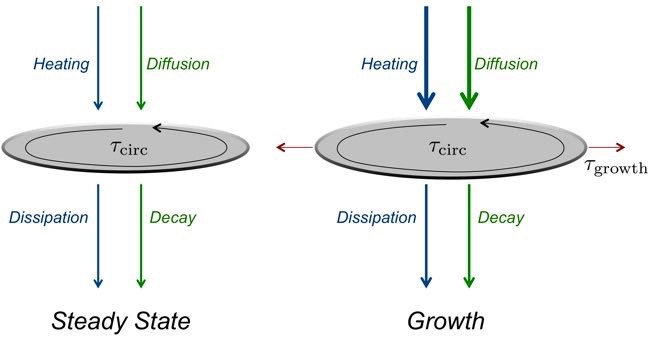The global economy as a heat engine
© TIM Garrett 2014
This work is licensed under a Creative Commons Attribution-NonCommercial 4.0 International License.
Modelling civilization as 'heat engine' could improve climate predictions - physicsworld.com Nov 27, 2008
Civilization is a heat engine. How? We as humanity consume energy and dissipate waste heat to sustain our internal circulations like the pistons in the internal combustion engine of car.
But we are a very special kind of heat engine rather different than the type envisioned by French engineers in the early 1800s.
In a car, energy is used to keep the engine moving and to do work to propel the car forward. Civilization also uses energy to keep it moving and to do work. But unlike a car, civilization can grow. By growing, its engine expands. A larger engine consumes more, dissipates more, and does work ever faster. This positive feedback provides a recipe for exponential growth.
Perhaps the most fundamental expression of the Second Law of Thermodynamics is that all systems are thermodynamically open, or more to the point, no system is perfectly isolated. All systems have flows in from where they have a high potential to do work, and they have flows out to a lower potential, like cascading pools in a waterfall.
High potential primary energy resources like oil and coal sustain civilization’s circulations against dissipation of waste heat. ‘Useless’ energy ultimately flows to space through the cold planetary blackbody temperature of 255 K. In between lies civilization, including people, their activities, and all their associated circulations, whether or not they are part of the GDP.

Thermodynamic representation of an open system with constant back-and-forth “reversible” internal circulations that have a constant potential and a characteristic period τcirc. Steady-state circulations shown on the left are sustained by a dissipation of a potential energy source that heats the system. The system maintains a steady state because high potential energy (blue) and matter (green) is consumed by the open system at the same rate rate the energy is dissipated leaving behind material waste. The right-hand diagram shows an open system that is out of balance, with more flowing into the system than out of the system. Here, the system grows irreversibly with time scale τgrowth ≫ τcirc.
In an economic system, the steady state circulations are associated with Wealth and the growth of these circulations is associated with the real GDP. The real GDP is positive only when consumption exceeds dissipation and material diffusion exceeds decay. Otherwise, we might expect unemployment, war, and hyper-inflation while civilization collapses.
Civilization uses energy consumption mostly to sustain existing circulations. A small fraction is also used to grow civilization through an incorporation of new raw materials (e.g. iron and wood) into its structure. This is possible only if the consumptive flow into civilization is greater than the dissipative flow out of civilization. In the case of a net convergence of flows, a small remaining fraction of energy is available to incorporate raw materials to build civilization. Only then does the GDP exist and is it possible to grow civilization’s value through positive economic production.
We’re actually pretty familiar with this. If we eat too much we get fat. I’m told that consuming an extra 3500 calories beyond what we need leads to a pound of weight gain. This is the energy required for the body to turn food into flesh.
A child consumes food today in some proportion to the child’s body mass. The child experiences a production of mass if there is a convergence of energetic flows such that it dissipates less heat than is contained in the food energy eaten. The child’s current size is directly a consequence of an accumulation of prior mass production. Its current rate of food consumption is also a consequence of prior production so the child eats more as it grows. As the child approaches adulthood, the disequilibrium between consumption and dissipation narrows, and the production of new mass (hopefully!) stalls.
In traditional macroeconomics, consumption is subtracted from production to obtain an investment that adds to total value. From a heat engine perspective, this isn’t quite the right way to describe the economy. Mathematically speaking, consumption and production are orthogonal because, although they may be related, they don’t happen at precisely the same time. At any given instant, subtracting one from the other is as nonsensical as subtracting the x co-ordinate from the y co-ordinate on a Cartesian plane.
Instead, production is better viewed as the consequence of an imbalance: production is positive only when primary energy consumption is greater than the rate at which civilization dissipates energy due to all it’s internal circulations. If production is positive, civilization is able to incorporate raw materials into its structure that allow it to grow to potentially (though not certainly) consume even more.
The relevant equation is that every 1000 dollars of year 2005 inflation-adjusted gross world product requires 7.1 additional Watts of power capacity to be added, independent of the year that is considered. If we ever fail to add consumption capacity, the global economy measurable by a GWP collapses.
Economics About Physics of the economy What is wealth?
Energy, Innovation and growth Economic inertia Economic Forecasting Jevons' Paradox
Physics vs Mainsteam Economics Is Macroeconomics a Science? The economic heat engine
Economics and Climate GDP is not Wealth Are renewables the answer?
Is population growth a problem? Will growth transition to collapse?
What is your carbon footprint? Media Publications Presentations FAQ Criticisms
